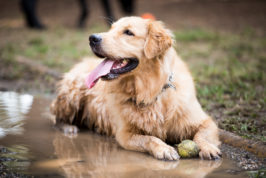The dangers of a skinny dog
We talk a lot about health issues in dogs that are overweight – but what if you’ve got an underweight dog that’s too skinny? Dr Ellen Marcinkiewicz explores the issue…
Too skinny versus lean and active
In lots of cases, skinny dogs are simply active and lean, and their appearance can vary greatly depending on the breed (think about a Greyhound compared to a Labrador). It is important, however, to differentiate lean body condition from a dog that is truly underweight, as the latter can be an indication of a much more serious problem.
How do you know if your dog is too thin?

Keeping your dog at an ideal body weight is known to benefit their health, happiness and mobility long-term. But many pet owners find it hard to tell if their pet is under or overweight. This is made even more difficult by the increasing prevalence of obesity in dogs, shifting the public perception as to what ‘normal’ or ‘healthy’ looks like.
In fact, obesity in pets has reached a crisis point, with veterinarians reporting that 51% of dogs in the UK are overweight or obese. As pet owners are now used to seeing overweight dogs, it’s not uncommon to receive a passing comment that your dog looks ‘a bit too skinny’, when they’re actually the perfect weight! This is why it’s always best to speak to your veterinary clinic if you’re concerned about your dog’s weight before intervening – you might end up making a healthy pet overweight.
Your vet or vet nurse will weigh your dog and use a technique known as Body Condition Scoring (or BCS) to determine if they are a healthy size. The Body Condition Scoring system looks at fat coverage over multiple points on the body, and assigns a score from one to nine. This will determine if your dog is in ideal body condition (score of four or five), underweight (three or lower) or overweight (six or higher).
A dog with an ideal BCS will have minimal fat coverage over the ribcage, and the ribs should be easy to feel. When viewed from above, they will also have a noticeable waist that tucks in between the ribs and the hips. Signs that your dog might be underweight include visible ribs, prominent hipbones and backbones (vertebrae), as well as noticeable muscle loss.
Why is it dangerous for a dog to be too skinny?
Just like being overweight, being underweight can also seriously impact a dog’s health. Consequences of being too skinny can include a weakened immune system, delayed wound healing, loss of muscle strength and reduced mobility.
Underweight dogs may also be suffering from nutritional deficiencies that can affect the body in many different ways, such as stunted growth and development, weakened bones, hormonal disorders and skin conditions.
If you think your dog may be underweight, it’s important to seek veterinary advice, as there are many different causes for weight loss, including underlying disease. Your veterinarian will usually need to perform diagnostic tests that may include blood and urine testing, faecal testing, ultrasound or x-rays to try and identify the underlying cause. Common reasons a dog may be underweight or losing weight include:
- Inadequate nutrition – your dog’s dietary intake doesn’t match their requirements
- Recovery after illness
- Difficulty eating – caused by a painful mouth, teeth or gums
- Parasites
- Diabetes, thyroid conditions and other hormonal diseases
- Cancer
- Heart Disease
- Kidney Disease
- Gastrointestinal diseases – such as Irritable Bowel Disease (IBD) or food intolerances
- Pain – caused by diseases such as Osteoarthritis (Arthritis)
If your dog continues to lose weight, they start to lose not only body fat but also vital muscle mass. This eventually leads to metabolic disturbances that can make your pet extremely ill, and will also have a huge impact on their strength, activity levels and quality of life.
How can I help my skinny dog?

Solutions to improve the health of a skinny dog will depend on the reason or underlying cause that’s contributing to them being underweight. Your vet will be able to advise you on treatment options and make nutritional recommendations that will benefit your pet’s unique situation. Some considerations and tips for commonly encountered conditions include:
Treating the treatable
Your veterinarian may be able to provide options to treat or manage the underlying condition that’s causing your dog to be underweight. For example, a dog that isn’t eating properly because they have sore and infected teeth can have a dental procedure under general anaesthesia to address the problem. Other examples include Diabetes, which can be well managed in dogs with the use of insulin, intestinal worms that can be treated with anti-parasitic drugs, and chemotherapy options to manage certain types of Cancer.
Nutritional know-how
Sometimes, the problem is that the food you’ve chosen isn’t the right one for the job. It’s important to feed your dog a high-quality, complete and balanced diet appropriate for their life stage (puppy or adult), lifestyle and any health conditions. Pet food labels can be confusing, and are highly driven by marketing, so it can be difficult to know which food is best for your pet.
That’s where your veterinarian is here to help. They can recommend a suitable high-quality diet to meet your dog’s needs. Active working dogs, in particular, burn through huge amounts of energy each day and need to be fuelled appropriately. Growing puppies and pregnant bitches also require specialised nutrition during these critical periods of development.
Sometimes, the problem with a particular diet is that it’s ‘unbalanced’ or deficient in essential nutrients. This is a common problem with home-cooked diets, and it’s important to seek the advice of a specialist veterinary nutritionist if you’re planning to cook your own meals for your pet.
Tummy troubles
Dogs with gastrointestinal disorders often struggle to absorb nutrients from food, and may experience a loss of nutrients due to Diarrhoea. This can lead to weight loss and difficulty maintaining a healthy body weight. Your veterinarian will recommend a suitable diet depending on their condition. For example, a highly digestible diet with added prebiotics is often highly beneficial for dogs suffering from Diarrhoea.
The population of bacteria, fungi, yeast, and microorganisms that keep our gut healthy and happy is known as the microbiome. Disturbances to the microbiome can lead to disease – known as Dysbiosis. Prebiotics are complex carbohydrates that naturally ferment within the gut, promoting the growth of healthy or ‘good’ bacteria.
It’s important to remember that not all prebiotics are created equal. Studies have shown fructo-oligosaccharides (FOS) and mannan-oligosaccharides (MOS) to be some of the most effective. Probiotics, on the other hand, are live bacteria given directly to populate the gut and try to restore balance. Probiotics have also been shown to benefit dogs suffering from Diarrhoea and Irritable Bowel Disease (IBD).
Weight loss in older dogs
Our dogs tend to lose muscle mass as they age, especially if they aren’t keeping active, and this can make them look skinnier. One of the most common reasons older pets start slowing down is Osteoarthritis, which causes joint pain and stiffness.
Dogs with Osteoarthritis can find walking and even standing up painful, so their muscles begin to waste away (atrophy) as they aren’t being used, making them look skinny. Just like in humans, there is no cure for dogs with Osteoarthritis. However, maintaining a healthy body weight, gentle exercise or physiotherapy, and the use of supplements containing Omega-3 fatty acids can help improve comfort and mobility. A multi-modal approach is often best to manage Osteoarthritis, and your veterinarian can also prescribe pain relief and discuss other options with you.
Conclusion
If you think your dog has lost weight or is looking a bit skinny, your veterinarian should be the first point of contact. They will be able to accurately weigh and body condition score your dog to determine if they are underweight or have lost weight quickly and help you work out why. As there are so many potential causes, from incorrect nutrition to a sore mouth, or even Diabetes, it’s important to identify why your dog is underweight in order to treat them effectively.




